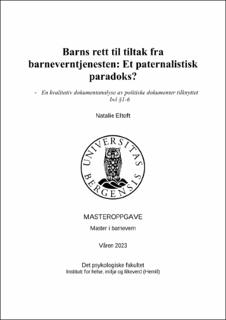Barns rett til tiltak fra barneverntjenesten: Et paternalistisk paradoks? - En kvalitativ dokumentanalyse av politiske dokumenter tilknyttet bvl §1-6
Master thesis
Permanent lenke
https://hdl.handle.net/11250/3069688Utgivelsesdato
2023-05-15Metadata
Vis full innførselSamlinger
- Master theses [157]
Sammendrag
Rettighetsfestingen av barns rett til tiltak fra barneverntjenesten, har vært en debatt i Norge siden utarbeidelsen av barnevernloven av 1992. Etter ikraftsettelsen av barnevernloven av 1992, har fire offentlige utvalg fra år 2000 til 2016 anbefalt myndighetene å rettighetsfeste barns rett til tiltak i barnevernloven. Norge fulgte anbefalingene først i 2016, og retten ble ikraftsatt i 2018 i barnevernloven av 1992 §1-5. Rettigheten ble videreført i barnevernloven av 2021 §1-6. Formålet med denne studien er å få en dypere forståelse for Norges valg om å rettighetsfeste barns rett til tiltak, og undersøke hva rettighetsfestingen betyr for barns rettslige posisjon i samfunnet. Studiens problemstilling er følgende: «Hva ledet til Norges valg om å implementere en rett til tiltak fra barneverntjenesten i barnevernloven, og hva betyr dette for barnet som rettighetssubjekt?» Studien anvender en kvalitativ dokumentanalyse, hvor det benyttes både innholdsanalyse og argumentasjonsanalyse på studiens datamateriale. Studiens datamateriale består av politiske dokumenter, som er publisert i perioden 2000-2016. Funnene diskuteres på bakgrunn av de teoretiske perspektivene paternalisme og barnet som aktør. Studiens funn viser at samfunnets syn på barn er i endring, og at barn har fått en sterkere juridisk posisjon. Barnets juridiske posisjon har styrket seg noe gjennom en rett til tiltak, blant annet i situasjoner hvor barnets og foreldrenes rettigheter er i et motsetningsforhold. Barnets juridiske posisjon har fortsatt svakheter, som innskrenker barnets mulighet som aktør. Samtidig viser funnene at Norge ikke alltid har barnets beste som vurderingstema i saker som omhandler barn. The legalization of children’s right to measures from the child protection service has been debated in Norway since the drafting of the Child Protection Act of 1992. Four public committees have recommended that authorities implement the right to measures, but it was not implemented into said law until 2016, and not enforced until 2018. The purpose of this study is to gain a deeper understanding of Norway’s choice not to enshrine children’s right to measures, and to examine what enshrining this right means for children’s legal standing in society. This study’s problem statement is the following: «What led to Norway’s choice to implement a right to measures from the child protection service into the Child Protection Act, and what does this mean for the child as a subject of rights?» The study uses a qualitative document analysis, where both content analysis and argumentation analysis are used on the study’s data material consisting of political documents published from 2000 through 2016. The findings are discussed on the background of the theoretical perspectives of paternalism and the child as actor. This study finds a clear development in society’s view of children and children’s legal standing. Children’s legal standing has been strengthened through the right to measures in situations where the rights of children and guardians are opposed. Children’s legal position does however still have weaknesses limiting the children as actors. The study also finds that in disputes, Norway does not always consider what’s best for the child.
